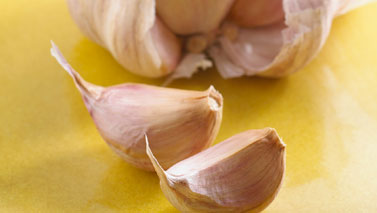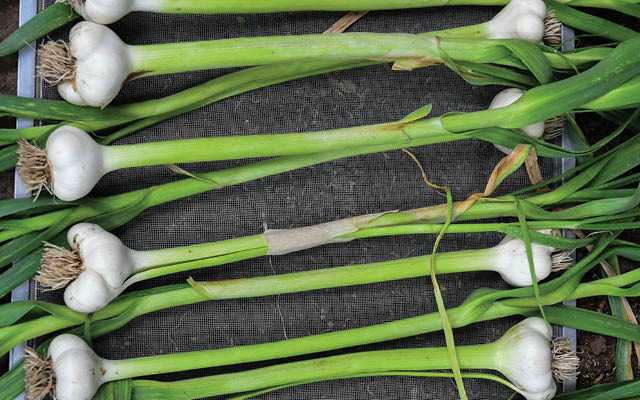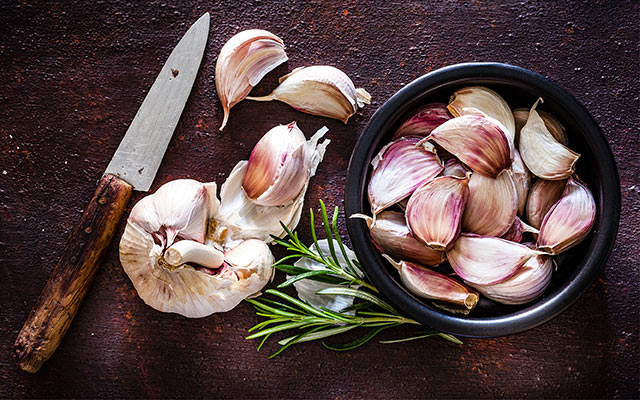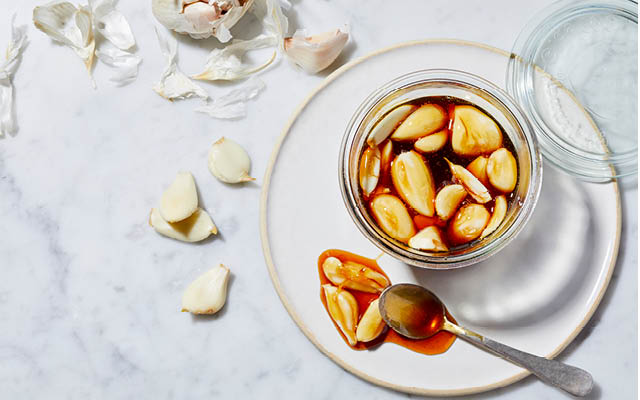Garlic is sometimes referred to as the “stinking rose.” In folklore, its pungent aroma has been credited with warding off evil spirits and vampires. Today, scientific studies tell us that this small, aromatic herb can help heal all sorts of ailments: Garlic can reduce the risk of heart disease, stroke and cancer, and it’s a strong antibacterial and antiviral agent. And, of course, it’s a delicious addition to all kinds of great meals.
Food Basics
Garlic belongs to the same plant genus as onions, leeks and chives. There are three major types of garlic available in the United States: white-skinned, strong-flavored American garlic; mauve-colored, milder-flavored Mexican and Italian garlic; and the even milder elephant garlic (not a true garlic, but aptly named for its extremely large cloves). You can purchase garlic in dehydrated and powdered forms, freeze dried, or in a paste, but whenever possible, reach for fresh garlic (preferably plump, compact and free of soft spots) to experience its crisp and vibrant flavor – and its best nutritional benefits.
Nutritional Know-How
Eating garlic regularly has been shown to lower blood pressure, help prevent atherosclerosis and diabetic heart disease, reduce the risk of heart attack and stroke, decrease free radicals in the blood stream, and inhibit the growth of cancer cells. That’s because garlic is rich in vitamins C and B6, selenium, manganese, and a variety of sulfur compounds. The compound allicin, one of the sources of garlic’s strong odor, is a powerful antibacterial and antiviral agent. To stimulate the enzymatic process that converts the phytonutrient alliin (a sulfoxide) into allicin, chop or crush the garlic, then wait several minutes before eating or cooking it. Avoid cooking garlic quickly: It inhibits the enzymatic process and doesn’t dissipate the odor.
Kitchen Tricks
- Store in a cool, dry, dark place – such as a loosely lidded ceramic dish, terra-cotta pot or glass jar. Avoid freezing uncooked garlic (it turns mushy when thawed).
- To peel cloves, place them flat-side down on a cutting board or smooth surface. Gently press down with the flat side of a wide knife until the skin splits, making it easy to peel it away and expose a clean clove.
- To remove garlic odor from your fingers, rub them against stainless steel – such as a kitchen sink or the inside of a spoon – under running water for about a minute. Or wash them with a tablespoon of table salt or baking soda and some warm water.
Eat Up!
Many people avoid eating garlic because of its strong odor. Raw garlic can be pretty powerful, but when cooked, garlic is milder and sweeter on the palate – and less lingering on your breath.
- When cooking garlic in stir-fry or sauté dishes, add as late in the recipe as possible and cook no longer than one minute over medium heat to prevent burning. When cooking separately, first heat some olive oil in a large pan, then add the garlic. Stir repeatedly to prevent sticking.
- When preparing soups or stews, first sauté denser vegetables like carrots, onions and celery. Then add garlic to prevent it from overcooking.
- To roast garlic, cut off the very top of the bulb to expose the tips of the cloves. Rub exposed garlic with extra-virgin olive oil, salt and pepper. Wrap in foil and bake in preheated 325-degree F oven for 11/2 hours, or until the cloves are soft and lightly brown on top. Allow to cool for three to five minutes, and then squeeze each clove from its skin. Spread directly on sliced bread or crackers for a delicious hors d’oeuvre, or mix with fresh cooked vegetables to create a spectacular side dish.
Broccoli Rabe with Toasted Garlic
Makes four servings
- 1 pound broccoli rabe, trimmed
- 1 tsp. salt
- 6 cloves garlic, sliced thin
- 1/4 cup extra-virgin olive oil
- 1 tsp. sea salt
- 1/2 tsp. freshly ground pepper
- 1 lemon cut in half
Fill a large pot with water, and bring to a boil with 1 teaspoon of salt. Stir in the broccoli rabe. While the broccoli rabe is cooking, heat the olive oil in a large sauté pan over medium heat. Add the sliced garlic. Stir the garlic continuously, and toast until golden brown (about one minute). Cook the broccoli rabe until al dente, or cooked thoroughly while maintaining a slight bit of crispness. Drain the broccoli rabe, and stir into the sauté pan with the toasted garlic. Season with the sea salt, black pepper and juice of one lemon. Serve immediately.
Per serving: Calories 160; Protein 3 g; Total Fat 14 g; Saturated Fat 2 g; Carbohydrate 9 g; Dietary Fiber 1 g; Cholesterol 0 mg; Sodium 1,170 mg|
Carpaccio of Artichokes, Bleeding Heart Radish, Carrots and Golden Beets
Serves four
Preparation
Artichoke
1 artichoke bottom, choke and stem removed and bottom thinly sliced vertically
1 tbs. extra-virgin olive oil
1 tbs. freshly squeezed lemon juice
Celtic sea salt and freshly ground pepper
Combine the artichoke, olive oil and lemon juice in a bowl, and toss to mix. Season to taste with salt and pepper.
Bleeding Heart Radish
1small bleeding heart radish, peeled and sliced into rounds
1 tbs. yuzu citron juice
1 tbs. cold-pressed sesame oil
Celtic sea salt and freshly ground pepper
1/4 tsp. freshly grated wasabi
2 tsp. grated, peeled apple
Combine the radish slices, citron juice and sesame oil in a bowl, and toss to mix. Season to taste with salt and pepper. Lay the slices flat. Mix together the wasabi and apple in a small bowl. Spread some of the mixture over each radish slice.
Carrots
1 carrot, thinly sliced on the diagonal
2 tbs. extra-virgin olive oil
2 tsp. red wine vinegar
Celtic sea salt and freshly ground pepper
Combine the carrot, olive oil and vinegar in a bowl, and toss to mix. Season to taste with salt and pepper.
Golden Beets
1 small golden (yellow) beet, peeled and thinly sliced
1/2 tsp. finely minced, peeled fresh ginger
1/2 tsp. finely minced garlic
1/2 tsp. finely minced shallot
2 tbs. extra-virgin olive oil
2 tsp. rice wine vinegar
Celtic sea salt and freshly ground pepper
Combine the beet, ginger, garlic, shallot, olive oil and vinegar in a bowl, and toss to mix. Season to taste with salt and pepper.
Garnish
2 tsp. fresh flat-leaf parsley leaves, cut into fine chiffonade
4 tsp. fresh micro mint leaves
1 tsp. chopped fresh dill
1 tbs. 1/2-inch-long-cut fresh chives
Freshly ground pepper
Assembly
For each serving, arrange one-fourth of each vegetable on a small plate, overlapping the pieces and, in the case of the golden beet, rolling the slices into cones. Spoon any of the remaining juices from each vegetable on the respective vegetable. Sprinkle the parsley evenly over the artichoke, the mint evenly over the radish, the dill evenly over the carrot and the chives evenly over the beet. Sprinkle the vegetables with pepper.
Recipe excerpted from Raw by Charlie Trotter and Roxanne Klein (Ten Speed Press, 2007).|
Roast Garlic Soup with Parmesan Crisp
Makes six servings
3 garlic bulbs
2 tsp. olive oil
1/8 tsp. salt
1/8 tsp. ground black pepper
1 tsp. olive oil
2 cups sliced onions
2 cups peeled, diced potatoes
1 tsp. chopped fresh thyme
1 bay leaf
6 cups vegetable stock
1/2 cup heavy cream or nonfat milk
1/2 tsp. salt
1/4 tsp. ground white pepper
1/3 cup shredded Parmesan cheese
2 tsp. chopped chives, parsley, or basil
Preheat the oven to 325 degrees F. Cut off the top of the garlic bulbs to expose most of the garlic cloves. Season the bulbs with 2 teaspoons of olive oil, salt and pepper. Wrap the bulbs in foil, and roast in oven for 45 minutes, or until the cloves are soft when squeezed. Remove the bulbs from oven, and let cool before handling. Separate the cloves from the bulbs by squeezing the cloves from the thin skin.
Heat a large saucepan over medium-high heat with olive oil. Add the onions, potatoes and thyme. Stir continuously, and sauté for two minutes. Stir in the roast garlic pieces, bay leaf and vegetable stock. Bring the contents to a boil, reduce the heat, and simmer for 15 to 20 minutes, or until the potatoes are soft and cooked throughout. Stir in the heavy cream, salt and pepper to taste. Remove and discard the bay leaf. Carefully pour the soup into a blender and purée until smooth.
Line a baking pan with parchment or waxed paper. Spoon 6 equal tablespoons of shredded Parmesan cheese onto the baking pan in a thin 1- to 2-inch circle, spaced widely apart to keep from baking together. Bake in a 350-degree-F oven for three to four minutes to melt cheese and lightly brown. Allow to cool.
Divide the soup among six soup bowls. Remove the Parmesan crisps from the pan, and serve one atop each bowl of soup. Garnish with chopped chives, parsley or basil.
Per serving:
Calories 260; Protein 7 g; Total Fat 11 g; Saturated Fat 6 g; Carbohydrate 36 g; Dietary Fiber 3 g; Cholesterol 30 mg; Sodium 710 mg




This Post Has 0 Comments